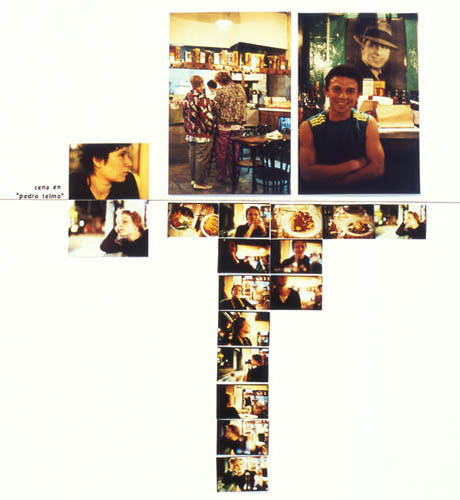TRANSIT
What was the reaction from people?
Saskia: They were fascinated, recognizing places; it’s always interesting when you see something from a stranger’s point of view, that is familiar to you.
It’s like when you do an exhibit of local places in a small town, people only search for places they already know, like their neighbor’s house.
Felipe: I brought two of my pieces here. A small sculpture and a football table. The football team member playing on his own is called “You should see how happy I am since you left me”. I like making metaphorical connections between my work and my personal relations. I compare sports to the competition among people.
Martina: I take documentary photos, I like to walk through the streets and take pictures. The project we do this year is quite the opposite to last year’s, because in London we took pictures of our own space and here we go through the streets of Buenos Aires. Last year we took self-portraits and this year we take portraits of each other, so we’re confronting the city and confronting ourselves.

Felipe Cravo, You should see how happy I am since you left me, 2002-2003, Mixed Media
What would you say is the connection between all of you?
Sigbjorn: We have similar influences and work in the fields of contemporary art, but each of us has different projects.
Saskia: We have a similar critical discourse due to our shared experience. Although we all grew up in different places, for one year we shared the same environment and we developed a similar approach to our work during the course.
Sharone: Yes, I think we are not English and that is something.
Felipe: We went to London looking for new experiences. School was really important; everyone there has influenced me.
Gabriel: What I had in mind when I went to London was finding as much as I could about the artistic field. The interesting part is the contrast between this traditional background and the contemporary art scene.
Sharone: Gabriel went through a big transition. It was interesting to see his work in relation to what happens here. When we came here it all made sense: he brought us here to show us in what kind of background his work emerged.
Gabriel: When I came to Buenos Aires, I got obsessed with keeping track of information of the art scene. This is a way of making it happen, somehow.

Gabriel Glaiman, Transit, 2003, Oil on canvas, 157 x 127.5cm
Would you say there is a theme in this exhibit?
Sharone: Would you?
Maybe the exhibit is a trip in itself, in which each artist represents a stop.
Saskia: That’s very accurate. The real similarity between our works is that we all are displaced.
Sharone: Traveling gives us the possibility to see what belongs to us, and what does not.
Gabriel: I think traveling is a way of negotiating things with yourself. For me, this show is like an intervention: to drop a group of artists in an institutional place and see what happens.
Sharone: More people will see our work here in one month than in the rest of our lives! There are so many people here; it’s an amazing opportunity to show our work to a very wide audience.
We keep on talking about contemporary art and London, and subjectivism and objectivism. Everyone gets involved in the conversation until we have to leave and then we exchange emails and we keep on talking, while more people transit in front of the art pieces. They are still brightening the place.
The artists are: Mark Beldan, Isha Bøhling, Sigbjørn Bratlie, Felipe Cravo, Martine Feipel, Gabriel Glaiman, Isabel Ivars, Martina Jenne, Maria Klabin, Sharone Lifschitz, Hugh McCarthy, Milan Milosavljevic, Anela Sabic and Saskia Wilson-Brown
Transit
Date: March 11th – April 11th, 2004
Place: Centro Cultural Recoleta
Address: 1930 Junin, C1113 Buenos Aires
Tel: +54 11 4803 1040
https://www.centroculturalrecoleta.org
Text: Gisella Lifchitz
Photos: Courtesy of Centro Cultural Recoleta © the artists






